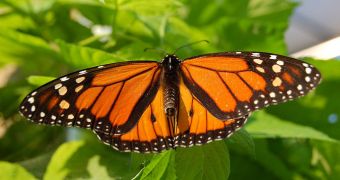In another example of the fine work natural selection puts forward when it comes to protecting the survival of the fittest, researchers have demonstrated that monarch butterflies have evolved to the impressive sizes they have today in order to become able to travel thousands of miles as they migrate. Long-distance flight takes a massive toll on all flying creatures, birds and insects alike, so special modifications are in order, if a certain species is to evolve to reach this goal. And apparently monarchs are very good at this, the BBC News reports.
In a paper published in the respected scientific journal Evolution, researchers show that the monarch butterflies that engage in massive migrations over the years tend to have a larger wingspan than those that remain put. In fact, they add, monarch butterflies that do not fly away during the summer or the winter tend to have wings that are 20 percent smaller than the ones their traveling counterparts sport. The creatures have the longest migratory route recorded for any insect. Every year, they travel in excess of 8,000 kilometers from Canada or the northern parts of the United States to Mexico, in search of warmer temperatures and a climate that is more beneficial for mating and reproduction.
Previous investigations into the changes traveling monarch butterfly species experience have demonstrated that various species of the same creature can evolve differently, especially in terms of wing spans and other adaptations to long flights. But the new investigation is one of the few to look at groups, or segments, of population, belonging to the same species, and the differences they undergo once they begin to fly during long migrations. In other words, the work looked at the influence that the butterflies' lifestyles had on their bodies.
“We were surprised that average wing size differences between migratory and non-migratory monarchs were so striking and consistent. Our findings indicate that large, elongated wings are better for monarchs that undertake long distance flights,” University of Georgia scientist, Professor Sonia Altizer explains. “When most people think about monarchs, they associate them with this incredible migration in North America, but a lot of people don't realise that monarchs also inhabit tropical locations such as Central America, the Caribbean islands, and Pacific islands, where they can breed year-round,” and don't need to migrate, she adds.

 14 DAY TRIAL //
14 DAY TRIAL //